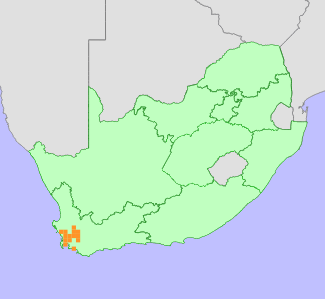|
Scientific Name | Babiana nervosa (Lam.) Goldblatt & J.C.Manning |
Higher Classification | Monocotyledons |
Family | IRIDACEAE |
Synonyms | Babiana stricta (Aiton) Ker Gawl., Babiana stricta (Aiton) Ker Gawl. var. erectifolia G.J.Lewis, Babiana stricta (Aiton) Ker Gawl. var. sulphurea in sense of G.J.Lewis (1959), not of (Jacq.) Baker (misapplied name), Gladiolus strictus Aiton |
Common Names | Bobbejaantjie (a), Bobbejaanuintjie (a), Katjetie (a) |
National Status |
Status and Criteria | Near Threatened B2b(iii) |
Assessment Date | 2023/02/17 |
Assessor(s) | H. Mtshali |
Justification | This species is relatively widespread, occurring mainly in restricted habitat of moist clays. It has an area of occupancy (AOO) of 396 km² and occurs at many (more than 50) locations. There has been a 65% loss of its habitat over the last 130 years due to crop cultivation and urban expansion. Its habitat continues to be transformed for agriculture and urban developments and is being degraded due to encroachment by invasive alien plants. It is therefore listed as Near Threatened under criterion B. |
Distribution |
Endemism | South African endemic |
Provincial distribution | Western Cape |
Range | It is endemic to the Western Cape Province, South Africa, extending from the Cape Peninsula eastward to Worcester and Swellendam. |
Habitat and Ecology |
Major system | Terrestrial |
Major habitats | Cape Flats Dune Strandveld, Swartland Shale Renosterveld, Central Ruens Shale Renosterveld, Western Ruens Shale Renosterveld, Swartland Granite Renosterveld, Greyton Shale Fynbos, Cape Winelands Shale Fynbos, Peninsula Granite Fynbos, Boland Granite Fynbos, Elim Ferricrete Fynbos, Hangklip Sand Fynbos, Swellendam Silcrete Fynbos, Lourensford Alluvium Fynbos, Breede Alluvium Fynbos |
Description | It grows in damp to waterlogged clay or gravelly soils in renosterveld or fynbos. |
Threats |
| About 65% (calculated using landcover data in GIS) of this species' habitat is irreversibly modified predominantly for crop cultivations as well as urban expansion around Cape Town and Stellenbosch. The habitat is being degraded due to encroachment from alien invasive plants. Although its habitat is transformed, this species still persists in remaining fragments of fynbos and renosterveld. |
Population |
The population size is unknown, however this species has been recorded from many subpopulations and there are 220 records on iNaturalist between 2006 and 2023. This is an indication that although the population is declining due to habitat loss, it is still locally abundant and widespread across its range.
|
Population trend | Decreasing |
Assessment History |
Taxon assessed |
Status and Criteria |
Citation/Red List version | | Babiana stricta (Aiton) Ker Gawl. | NT B1ab(ii,iii,iv,v) | Raimondo et al. (2009) | |
Bibliography |
Goldblatt, P. and Manning, J.C. 2000. Cape Plants: A conspectus of the Cape Flora of South Africa. Strelitzia 9. National Botanical Institute, Cape Town.
Goldblatt, P. and Manning, J.C. 2006. Notes on the systematics and nomenclature of Tritonia (Iridaceae: Crocoideae). Bothalia 36(1):57-61.
Goldblatt, P. and Manning, J.C. 2020. Iridaceae of southern Africa. Strelitzia 42. South African National Biodiversity Institute, Pretoria.
Raimondo, D., von Staden, L., Foden, W., Victor, J.E., Helme, N.A., Turner, R.C., Kamundi, D.A. and Manyama, P.A. 2009. Red List of South African Plants. Strelitzia 25. South African National Biodiversity Institute, Pretoria.
|
Citation |
| Mtshali, H. 2023. Babiana nervosa (Lam.) Goldblatt & J.C.Manning. National Assessment: Red List of South African Plants version . Accessed on 2025/07/06 |
 Comment on this assessment
Comment on this assessment

